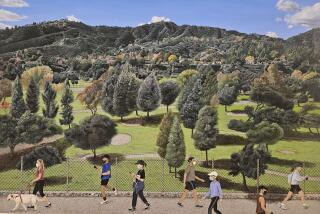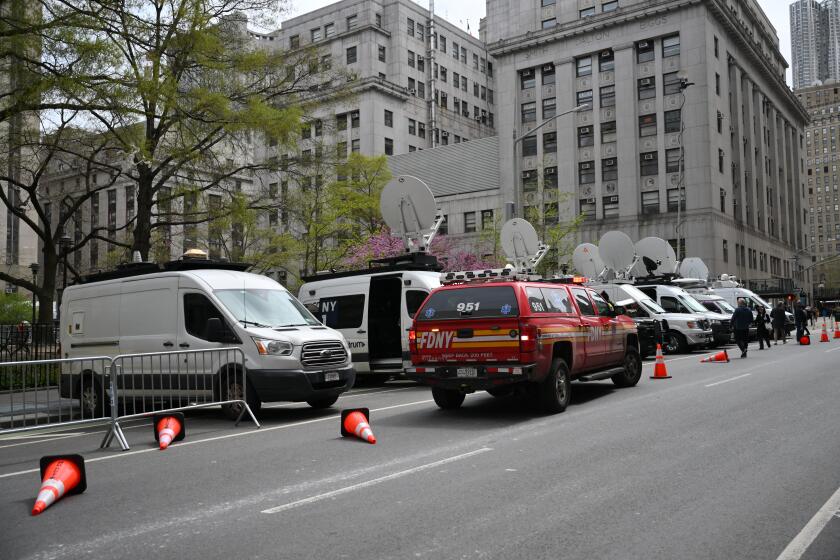Great Read: Artists finding inspiration in China’s bad air
Photographer Wu Di’s studio, tucked away in a dusty corner of northeast Beijing, isn’t easy to find, but the mannequin out front wearing a military-style gas mask and a Roots sweatshirt is a sign you’re in the right place.
Inside, Wu showed off some of his work, like the stylized shot of mannequins in brand-name clothes posed near a swirling cesspool of discharge from garment factories. Recently, he photographed a child wearing 445 paper face masks stretching out like an elephant’s trunk.
“The government has promised the air quality will meet standards in 2030. So that means we’ll have about 1,500 days of air below the standard between now and then. If you need one mask every three days, that’s 445,” he said, explaining his calculation using the number of “good days” and “bad days” in those 16 years.
The backbeat to life in China these days is a drone of statistics about the degraded environment: State media have reported that nearly 60% of China’s groundwater is polluted and 19.4% of farmland is contaminated. Of 2,028 days between April 2008 and March 2014, Beijing had just 25 days of air quality considered “good” by U.S. standards, figures from the U.S. Embassy here showed.
The reports aim to inform and even shock citizens and officials into action, yet the effect can be the opposite — paralyzing.
Increasingly, though, artists are finding their muse in the ecological mire. With photos, paintings, conceptual pieces and performances, they’re piercing through the din of data, seizing the attention and imagination of both the authorities and the public.
Beijing artist Liang Kegang grabbed headlines recently when he auctioned off some fresh air from France; the small glass jam jar with a hinged top, rubber seal and simple sticker — “Aix en Provence, FRANCE” — sold for about $860.
On a gloomy, bad-air day this winter, 20 artist friends wearing face masks convened at the capital’s Temple of Heaven and lay down on the ground. Later, they posed for a tourist-like group shot, each clutching a typical postcard of the historic site that showed the cake-like tiers of the structure stretching out against a blue sky.
On another smoggy day, Wu composed a photo of a young girl with an oxygen tube running from her nose to a green, heart-shaped balloon. It made the pages of Chinese Newsweek and other publications.
Recently, Wu has been tramping through nearby Hebei province, home to seven of China’s 10 most polluted cities. The factories and power plants that produce much of Beijing’s haze are there; Wu has posed people “camping” in a bleak field in front of one complex, and doctors dancing in another.
“It’s easier, in a way, to shoot documentary photos, but using an artistic way seems to make more of a difference,” said Wu, who has taken journalistic pictures for Greenpeace. “The artistic way has more impact and lasts longer.”
::
From afar, Yao Lu’s works look like poetic scenes of mountains, rivers and waterfalls, with craggy trees and little pavilions. Examine them closely, though, and you’ll see heaps of detritus and rubble.
Like Wu, Yao has found inspiration in China’s blighted landscapes, though his computer-centric approach is less risky and his style less confrontational. Using software, Yao has taken his photos of Beijing garbage mounds and digitally layered them with elements from traditional Chinese landscape brush-and-ink paintings.
Yao said inspiration struck before the 2008 Summer Olympics, when seemingly every quarter of Beijing was under construction.
“There were just mountains of garbage, many covered with green cloths,” he said. “These reminded me of paintings from the Song Dynasty.”
Yao’s “New Landscapes” series evolved slowly; over the last seven years he has created about 35 pieces, exhibiting in Europe, New York, South Korea, Singapore and elsewhere. (You can view his works on a free iPad app as well.)
Though the reception has been strong, particularly overseas, the project has been a bit draining emotionally. In 2013, he decided to halt work on the pieces.
“I was not very excited when I did this series. Of course, I was excited about the composition and the elements, but I felt heavy,” he recalled.
“In a way, it shows how we are sort of helpless — Chinese painting is a product of the spiritual high ground of Chinese intellectuals. Now, such high ground consists of piles of garbage.”
When painter Ai Song embarked on his 16-piece series “Health Check,” it was winter 2011, Beijing was blanketed in snow, and the air pollution was off the charts. Ai noticed that the snow looked very dirty, so he gathered up a bunch and put it in a cold room.
In the ensuing days, he sculpted the snow into shapes of human organs, including lungs. He placed the mounds on absorbent paper and let it melt, creating gray patterns.
“Air can’t be seen, but you can feel it inside your body. Imagine all these particles and dirt entering your body every day,” he said. “You’re not in a good mood.”
Ai’s use of smoggy snow calls to mind the work of downtown L.A. artist Kim Abeles, who moved to Southern California in the late 1970s and was shocked by the haze.
“When I first moved here, I’d mention it to people all the time and they would try to convince me it was just fog,” she recalled.
So she began making art about the topic; her series “The Smog Collectors” includes pieces such as a silk tablecloth that was “stenciled” by leaving it outside. Her “Presidential Commemorative Smog Plates” feature portraits of U.S. leaders and their quotes on the environment and business, made with smog residue.
“Art paves the way to open up dialogue where people don’t want to talk about it,” Abeles said. Eventually, the state of California began funding some of her pieces to raise public awareness about air pollution, automobile emissions testing and ride-share programs.
::
Dutch artist Daan Roosegaarde is hoping Chinese officials will take a similar shine to his pollution-themed work. He has devised an ambitious project to hoover contaminants out of Beijing’s dirty skies using a giant vacuum cleaner-type device. The pollution particles, he says, can be compressed into something resembling gemstones, and sales of the jewelry — he’s thinking 1 million rings priced around $30 — can fund the purification technology.
In March, Roosegaarde was invited to a soiree at Amsterdam’s Royal Palace, where the Dutch king was hosting Chinese President Xi Jinping. He had about eight minutes with the Chinese leader, so he decided to cut right to the chase.
“I told him: We are inspired by your smog,” said Roosegaarde, who also chatted with Xi’s wife, Peng Liyuan.
Xi “looked at me a bit weird. And the official people became a bit nervous, because … you know China, they don’t like to be too confronted with it. But at the same time, it is there. You cannot ignore it,” said Roosegaarde, who splits his time between Europe and Shanghai. “Then he saw the smog rings and he was like, ‘Oh, you daring Dutch!’ They really liked it.”
In a few weeks, he’ll be in Beijing meeting with city representatives about funding and the possibility of installing his vacuum cleaner in a public park.
The concept is akin to a huge ionic air purifier. If you create a large electrostatic field, pollutants in the air become positively charged and are attracted toward a collector plate.
“These kind of projects are not the solution for smog. It’s clean industry, electric cars,” he said. But the park and rings are experiences, he added, that move people “away from all the numbers and the fact sheets.”
One problem, though, is that Roosegaarde’s vacuum will yield only enough particles to create 15 or 16 smog rings a day. He wants to manufacture and sell rings even before the vacuum is installed in Beijing to increase public interest in the project — and raise funds.
So, he’s planning to assign interns to visit schools, hospitals and other facilities that have air purifiers to gather up the particles to be processed into jewelry. “That’s going to be a new job: smog collector,” Roosegaarde said.
“Innovation does not just come from scientists and science but indeed from artists and the creative side of people. When you look at the history of art, artists like Michelangelo and Da Vinci always had a relationship with art and technology,” Roosegaarde said. “It’s great to have radical ideas combined with high-tech — then you get a new world, you get the possibility to update reality.”
Nicole Liu in The Times’ Beijing bureau contributed to this report.
More to Read
Start your day right
Sign up for Essential California for news, features and recommendations from the L.A. Times and beyond in your inbox six days a week.
You may occasionally receive promotional content from the Los Angeles Times.







